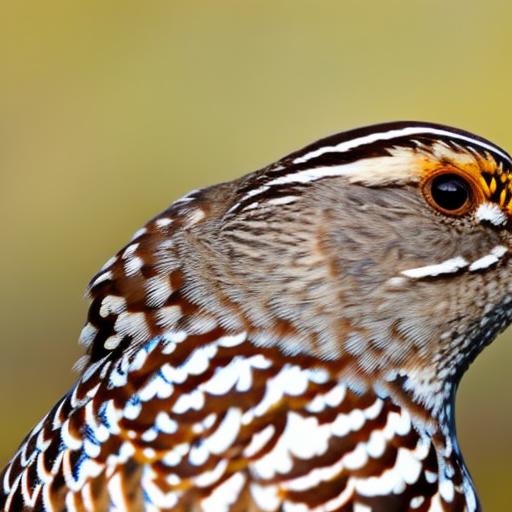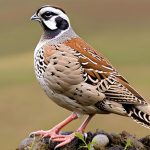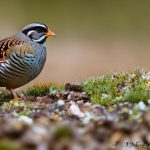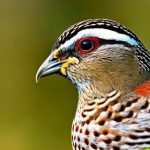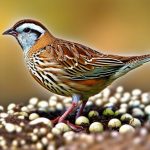Bobwhite quail, also known as northern bobwhite, are small, ground-dwelling birds native to North America. They are popular game birds and are often sought after by hunters for their delicious meat and challenging hunting experience. Bobwhite quail are known for their distinctive “bob-white” call, which is often heard in the early morning and late evening. These birds are social creatures and are often found in coveys, which are small groups of birds that forage and roost together.
Bobwhite quail prefer open grasslands, agricultural fields, and brushy areas with scattered shrubs and trees. They are ground-nesters, meaning they build their nests on the ground, usually in grassy or shrubby areas. Bobwhite quail are primarily seed-eaters, but they also consume insects and other invertebrates, especially during the breeding season. These birds are known for their strong flight and quick movements on the ground, making them elusive and challenging to hunt.
Bobwhite quail populations have been declining in recent years due to habitat loss, changes in agricultural practices, and predation. Conservation efforts are underway to protect and restore bobwhite quail habitats and populations, but landowners can also play a crucial role in supporting these birds by creating suitable habitats, providing adequate food and water, managing predators and pests, and monitoring and maintaining populations on their properties.
Key Takeaways
- Bobwhite quail are ground-dwelling birds native to North America, known for their distinctive “bob-white” call.
- Creating a suitable habitat for bobwhite quail involves providing a mix of grasses, forbs, and shrubs for nesting and cover.
- Providing adequate food and water for bobwhite quail includes planting food plots and maintaining water sources such as ponds or bird baths.
- Managing predators and pests in bobwhite quail habitats may involve controlling snakes, raccoons, and fire ants.
- Monitoring and maintaining bobwhite quail populations involves conducting population surveys and habitat assessments.
- Conservation and legal considerations for bobwhite quail include understanding hunting regulations and participating in conservation programs.
- Tips for attracting and keeping bobwhite quail on your property include minimizing disturbance, providing diverse habitat, and avoiding chemical pesticides.
Creating a Suitable Habitat for Bobwhite Quail
Creating a suitable habitat for bobwhite quail is essential for supporting healthy populations of these birds on your property. Bobwhite quail thrive in open grasslands, agricultural fields, and brushy areas with scattered shrubs and trees. To create a suitable habitat, landowners can implement habitat management practices such as prescribed burning, brush management, and native grassland restoration. Prescribed burning can help maintain open grasslands by reducing woody encroachment and promoting the growth of native grasses and forbs, which are important food sources for bobwhite quail.
Brush management involves selectively removing or thinning out woody vegetation to create open spaces and improve visibility for bobwhite quail. This practice can also help reduce the risk of predation by creating a more open and accessible habitat for these ground-dwelling birds. Native grassland restoration involves planting native grasses and forbs to provide food and cover for bobwhite quail. These practices can help create a diverse and suitable habitat for bobwhite quail, supporting their nesting, foraging, and roosting needs.
In addition to habitat management practices, landowners can also create habitat features such as brush piles, hedgerows, and edge habitats to provide additional cover and shelter for bobwhite quail. These features can help create a more diverse and complex habitat that meets the needs of bobwhite quail throughout the year. By creating a suitable habitat for bobwhite quail, landowners can support healthy populations of these birds on their properties and contribute to their conservation.
Providing Adequate Food and Water for Bobwhite Quail
Providing adequate food and water is essential for supporting healthy populations of bobwhite quail on your property. Bobwhite quail are primarily seed-eaters, but they also consume insects and other invertebrates, especially during the breeding season. Landowners can support bobwhite quail by providing food sources such as native grasses, forbs, and seed-bearing plants that are important for their diet. Planting food plots with a diverse mix of native grasses and forbs can provide year-round food sources for bobwhite quail and support their nutritional needs.
In addition to food sources, providing access to water is crucial for bobwhite quail, especially during dry periods. Landowners can create water sources such as small ponds, wetlands, or artificial water sources to provide drinking and bathing opportunities for bobwhite quail. These water sources can also attract insects and other invertebrates that are important food sources for bobwhite quail, supporting their dietary needs throughout the year.
By providing adequate food and water for bobwhite quail, landowners can support healthy populations of these birds on their properties and contribute to their conservation. These efforts can help ensure that bobwhite quail have access to the resources they need to thrive and reproduce, ultimately contributing to the sustainability of these iconic game birds.
Managing Predators and Pests in Bobwhite Quail Habitats
Managing predators and pests is essential for protecting bobwhite quail populations on your property. Predation is a significant threat to bobwhite quail, especially during the nesting and brood-rearing seasons. Common predators of bobwhite quail include raptors, snakes, mammals, and other ground-dwelling birds. To manage predators, landowners can implement predator control measures such as trapping, fencing, or using predator deterrents to reduce the risk of predation on bobwhite quail nests and broods.
In addition to predators, pests such as fire ants can also pose a threat to bobwhite quail populations. Fire ants are aggressive insects that can prey on bobwhite quail eggs and chicks, reducing their survival rates. To manage fire ants, landowners can implement pest control measures such as baiting or treating fire ant mounds to reduce their impact on bobwhite quail populations.
By managing predators and pests in bobwhite quail habitats, landowners can help protect these birds from potential threats and support healthy populations on their properties. These efforts can help reduce the risk of predation and pest-related impacts on bobwhite quail nests and broods, ultimately contributing to the conservation of these iconic game birds.
Monitoring and Maintaining Bobwhite Quail Populations
Monitoring and maintaining bobwhite quail populations is essential for understanding population trends and implementing conservation measures on your property. Landowners can monitor bobwhite quail populations through surveys such as call counts, covey counts, or nest searches to assess population abundance and reproductive success. These surveys can provide valuable information about the status of bobwhite quail populations on your property and help guide management decisions to support these birds.
In addition to monitoring populations, landowners can implement habitat management practices such as prescribed burning, brush management, and native grassland restoration to maintain suitable habitats for bobwhite quail. These practices can help create diverse and productive habitats that meet the needs of bobwhite quail throughout the year. By maintaining suitable habitats, landowners can support healthy populations of bobwhite quail on their properties and contribute to their conservation.
By monitoring and maintaining bobwhite quail populations, landowners can gain valuable insights into population dynamics and habitat needs, ultimately contributing to the sustainability of these iconic game birds. These efforts can help ensure that bobwhite quail have access to suitable habitats and resources to thrive and reproduce, ultimately supporting their long-term conservation.
Conservation and Legal Considerations for Bobwhite Quail
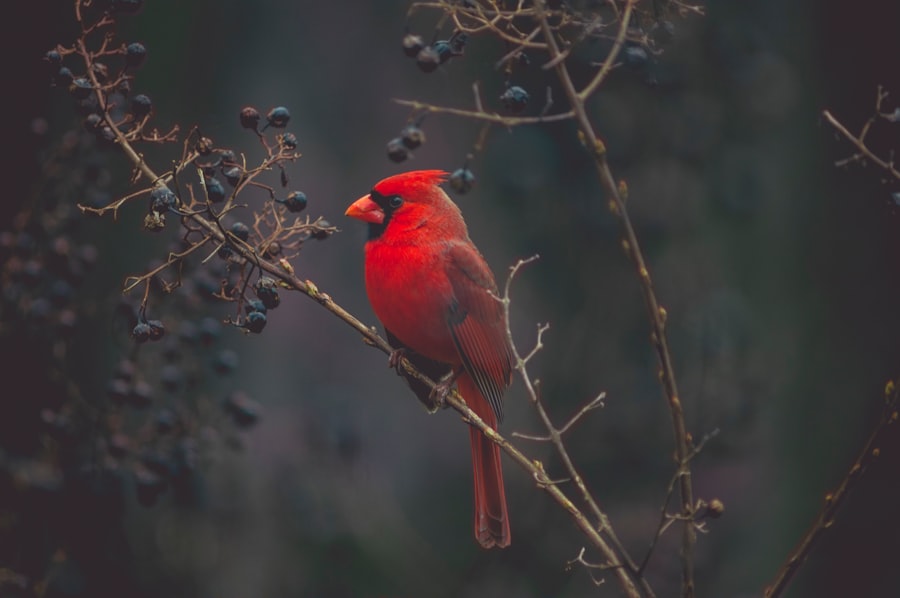
Conservation and legal considerations play a crucial role in supporting bobwhite quail populations on your property. Bobwhite quail are a popular game bird species that are subject to hunting regulations in many states. It is important for landowners to be aware of hunting seasons, bag limits, and other regulations related to hunting bobwhite quail on their properties. By following hunting regulations and practicing ethical hunting practices, landowners can contribute to the sustainable management of bobwhite quail populations.
In addition to hunting regulations, conservation efforts are underway to protect and restore bobwhite quail habitats and populations. Landowners can participate in conservation programs such as the Conservation Reserve Program (CRP) or other habitat enhancement initiatives to support bobwhite quail on their properties. These programs provide financial incentives for implementing habitat management practices that benefit wildlife, including bobwhite quail.
By participating in conservation programs and adhering to hunting regulations, landowners can contribute to the conservation of bobwhite quail populations on their properties. These efforts can help ensure that bobwhite quail have access to suitable habitats and resources to thrive and reproduce, ultimately supporting their long-term sustainability.
Tips for Attracting and Keeping Bobwhite Quail on Your Property
Attracting and keeping bobwhite quail on your property requires careful planning and management practices that support the needs of these iconic game birds. To attract bobwhite quail, landowners can create suitable habitats by implementing habitat management practices such as prescribed burning, brush management, and native grassland restoration. These practices can help create diverse and productive habitats that meet the needs of bobwhite quail throughout the year.
In addition to habitat management practices, providing adequate food and water is essential for attracting and keeping bobwhite quail on your property. Planting food plots with a diverse mix of native grasses and forbs can provide year-round food sources for bobwhite quail, while creating water sources such as small ponds or artificial water sources can provide drinking and bathing opportunities for these birds.
Managing predators and pests is also crucial for attracting and keeping bobwhite quail on your property. Implementing predator control measures such as trapping or fencing can help reduce the risk of predation on bobwhite quail nests and broods, while managing pests such as fire ants can help protect these birds from potential threats.
By creating suitable habitats, providing adequate food and water, managing predators and pests, monitoring populations, participating in conservation programs, adhering to hunting regulations, landowners can attract and keep healthy populations of bobwhite quail on their properties. These efforts can contribute to the conservation of these iconic game birds while providing valuable recreational opportunities for hunters and wildlife enthusiasts alike.
If you’re interested in keeping bobwhite quail in the UK, you may also want to explore the benefits of creating a garden chicken coop. This article on PoultryWizard.com provides valuable insights into how to design and maintain a functional and attractive coop that can enhance the well-being of your poultry. Check out “The Chicken Coop Country Diner” for expert tips on creating a comfortable and efficient space for your feathered friends.
FAQs
What is the habitat of bobwhite quail?
Bobwhite quail are found in open grasslands, agricultural fields, and brushy areas throughout the southeastern United States. They prefer areas with a mix of grasses, weeds, and shrubs for cover and nesting.
What do bobwhite quail eat?
Bobwhite quail primarily feed on seeds, grains, and insects. Their diet may also include small fruits and green vegetation.
How can I attract bobwhite quail to my property?
To attract bobwhite quail to your property, you can create suitable habitat by maintaining a mix of grasses, weeds, and shrubs. Providing food sources such as seed-bearing plants and insects can also help attract quail.
Are bobwhite quail legal to keep in the UK?
In the UK, it is illegal to keep bobwhite quail as they are considered non-native and invasive species. It is important to adhere to local wildlife regulations and conservation laws.
What are the conservation efforts for bobwhite quail?
Conservation efforts for bobwhite quail include habitat restoration, predator management, and controlled hunting regulations. Organizations and agencies also work to raise awareness about the decline of bobwhite quail populations and promote conservation practices.
Meet Walter, the feathered-friend fanatic of Florida! Nestled in the sunshine state, Walter struts through life with his feathered companions, clucking his way to happiness. With a coop that’s fancier than a five-star hotel, he’s the Don Juan of the chicken world. When he’s not teaching his hens to do the cha-cha, you’ll find him in a heated debate with his prized rooster, Sir Clucks-a-Lot. Walter’s poultry passion is no yolk; he’s the sunny-side-up guy you never knew you needed in your flock of friends!

